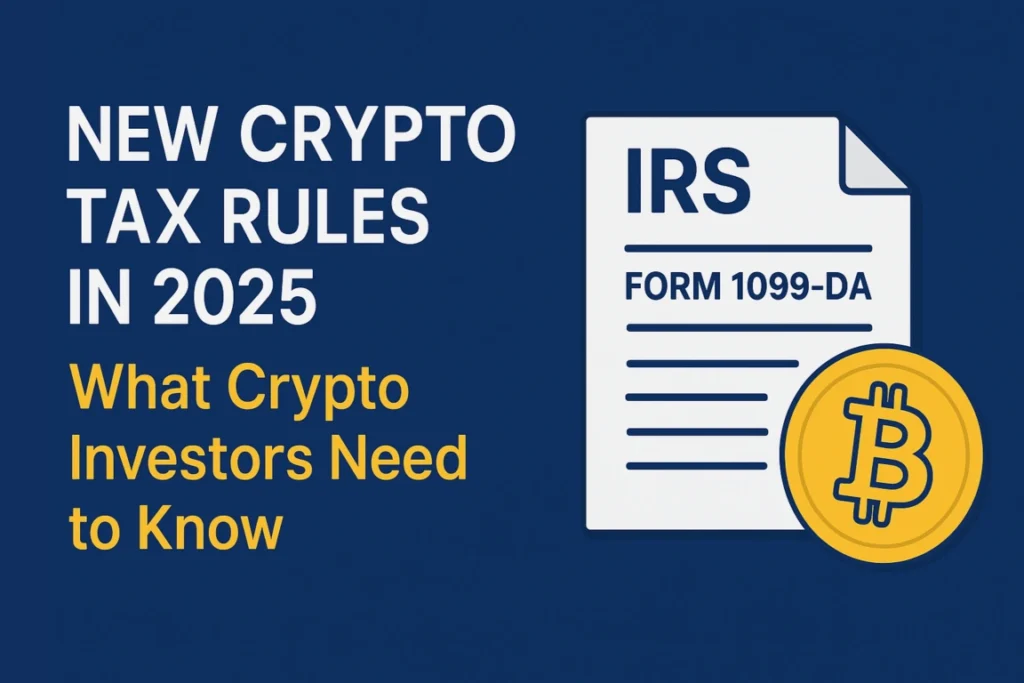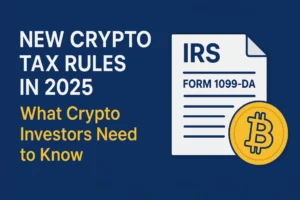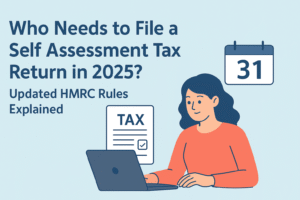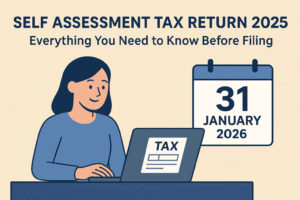New Crypto Tax Rules in 2025 & What Crypto Investors Need to Know


Faham
11/14/2025
Table of Contents
In the past, crypto investors had it relatively easy. You could connect your exchanges and wallets to a tax software, generate a report, and file your return without worrying too much about precision. But starting in 2025, that’s changing significantly.
The Internal Revenue Service (IRS) has introduced new crypto tax regulations aimed at tightening compliance and ensuring accurate reporting of digital asset transactions. These include the introduction of Form 1099-DA and the wallet-by-wallet cost basis rule, both of which will completely redefine how crypto income and gains are reported.
For investors, these changes mean one thing: more transparency, more data sharing, and less margin for error. Whether you trade occasionally or manage multiple wallets across exchanges, understanding these new rules is essential before tax season begins.
This guide breaks down everything crypto investors need to know from what’s changing in 2025 to how you can prepare, avoid penalties, and file your taxes accurately.
The Evolution of Crypto Taxation
Before 2025, crypto taxation in the U.S. was built on a patchwork of guidance. The IRS treated cryptocurrencies as property, which meant investors had to report gains or losses whenever they sold, swapped, or spent their crypto. However, exchanges were not required to report transaction-level data to the IRS, leaving room for inconsistencies and underreporting.
That gap is now closing.
Starting in January 2025, digital asset brokers including major exchanges and certain wallet providers will begin reporting user data directly to the IRS. This marks a major step toward standardized oversight, similar to what already exists for traditional financial instruments like stocks and bonds.
Old Rules vs. New Rules (Quick Comparison)
| Aspect | Before 2025 | From 2025 Onwards |
|---|---|---|
| Reporting Form | None (self-reported via Form 8949) | Form 1099-DA (filed by brokers) |
| Broker Definition | Limited to centralized exchanges | Includes wallet providers, DEXs (in some cases) |
| Cost Basis Method | Aggregated or flexible | Wallet-by-wallet mandatory |
| IRS Oversight | Minimal (user-driven) | Automated and data-driven |
| Compliance Risk | Low–Moderate | High (auto-reporting and penalties) |
This transition represents a new era of data transparency and traceability in the crypto market. The IRS aims to make tax compliance easier to verify and much harder to avoid.
For investors, the key takeaway is that every transaction now matters, and your reporting accuracy will soon be cross-checked automatically.
Understanding Form 1099-DA
To improve compliance, the IRS is rolling out Form 1099-DA (Digital Assets) the crypto equivalent of the traditional 1099-B form used for securities.
What is it?
Form 1099-DA will report your digital asset transactions including sales, exchanges, and certain transfers directly to the IRS. This means every time you sell or trade crypto through a registered broker, that information will automatically be sent to the tax authority.
Who must issue it?
Starting January 2025, crypto exchanges, brokers, and some wallet providers will be required to issue Form 1099-DA to both users and the IRS. If you use centralized exchanges like Coinbase, Kraken, or Gemini, expect to receive one by early 2026 for the 2025 tax year.
What information will it include?
Type of digital asset
Date acquired and sold
Sale proceeds and cost basis
Wallet or exchange ID
Customer identification details
Form 1099-DA Timeline
| Event | Date |
|---|---|
| New reporting rules take effect | January 1, 2025 |
| Exchanges start collecting transaction data | Throughout 2025 |
| Form 1099-DA issued to users and IRS | January 2026 |
| First IRS cross-check season | April 2026 tax filing period |
Pro Tip:
If you don’t receive Form 1099-DA but you traded crypto during 2025, you’re still responsible for reporting it. Always maintain your own records using a crypto tax tool or manual logs to avoid discrepancies.

Wallet-by-Wallet Cost Basis Rule
One of the most significant and complex changes taking effect in 2025 is the introduction of the wallet-by-wallet cost basis rule. This update redefines how crypto investors calculate their gains and losses, directly impacting how much tax they owe.
Previously, investors could use aggregate cost basis methods, such as pooling or flexible identification (FIFO, LIFO, HIFO), across multiple wallets and exchanges. This made it easier to minimize taxable gains and simplify reporting.
From January 1, 2025, however, the IRS requires taxpayers to calculate the cost basis for each individual wallet or account separately. This rule aims to prevent users from mixing transaction data across platforms and to increase transparency in crypto reporting.
What Does “Wallet-by-Wallet” Mean?
Under the new rule, every wallet you own whether it’s on an exchange like Binance or a hardware wallet like Ledger must be treated as an independent entity for tax purposes.
For example:
Let’s say you bought 1 BTC in each of the following wallets:
| Wallet | Purchase Price | Date Bought | Selling Price (2025) | Gain/Loss |
|---|---|---|---|---|
| Coinbase Wallet | $30,000 | 2023 | $45,000 | +$15,000 |
| Binance Wallet | $40,000 | 2024 | $45,000 | +$5,000 |
| Ledger (Hardware) | $50,000 | 2024 | $45,000 | -$5,000 |
Before 2025, you might have combined all these purchases and reported an average gain.
Now, under the wallet-by-wallet rule, you must calculate each wallet’s individual gain or loss, and report them separately on Form 8949.
Why Is This Change Important?
The goal behind this rule is accuracy and traceability.
By forcing investors to account for each wallet separately, the IRS can:
Track the exact flow of digital assets.
Prevent taxpayers from averaging gains to reduce liability.
Detect discrepancies between exchange reports and user filings.
For active traders, this means more precise record-keeping and potentially more taxes owed if profitable wallets can no longer offset losses from others.
Safe Harbor Guidance (Rev. Proc. 2024-28)
To ease the transition, the IRS introduced a temporary safe harbor rule under Revenue Procedure 2024-28.
This allows taxpayers to use a reasonable allocation method for cost basis if they cannot determine wallet-level details before 2025.
However, this relief is temporary full compliance will be required starting with the 2026 tax season.
In short, 2025 is the year to get your records in order.
Practical Example
Suppose you bought 2 ETH in 2022 for $2,000 each and later transferred them between wallets. You sell 1 ETH in 2025 for $3,500.
If you can’t clearly document which wallet that ETH came from, you may face IRS challenges when determining the correct gain.
The wallet-by-wallet method eliminates such ambiguity but only if your records are well-maintained.
What You Should Do Now
To prepare for this change:
Label all wallets and exchanges you use.
Record every transfer (date, wallet, value).
Use a crypto tax tracking tool that supports wallet-level accounting.
If you have prior records in bulk, start reconciling them before the 2025 filing season.
This new rule may seem like a burden, but it also provides a chance for crypto investors to improve financial accuracy and audit readiness something that will become essential as IRS oversight expands.
How Exchanges Will Report Under the New Law
The new crypto tax regulations for 2025 significantly expand the IRS definition of a “broker.” This means that more digital asset platforms from centralized exchanges to certain wallet providers will now have reporting obligations similar to traditional financial institutions.
Under the new law, any platform that facilitates the sale or exchange of digital assets for customers will be considered a broker and required to report detailed transaction data to the IRS using Form 1099-DA.
Who Qualifies as a Broker in 2025?
According to the IRS, a “broker” now includes:
Centralized exchanges (e.g., Coinbase, Kraken, Gemini)
Custodial wallet providers that execute transactions for users
Certain DeFi platforms or intermediaries that process digital asset trades
Payment processors that convert crypto to fiat on behalf of users
This broader definition ensures that any entity involved in transferring or trading digital assets is part of the official reporting system.
However, the IRS has also clarified that non-custodial wallets such as Ledger, Trezor, or MetaMask are not currently required to report transactions, since they don’t act as intermediaries. That said, as DeFi evolves, future updates could extend these requirements further.
What Exchanges Will Report
Starting January 2025, exchanges must collect and report the following data for each transaction:
Customer name and taxpayer identification number (TIN)
Digital asset type and transaction ID
Purchase and sale dates
Gross proceeds and cost basis
Wallet address or account ID associated with the trade
This information will be automatically sent to both the IRS and the user through Form 1099-DA by early 2026.
Impact on Investors
For most crypto investors, this means the IRS will already know your crypto trading history before you file your tax return.
While this may simplify compliance, it also eliminates the flexibility some users had in self-reporting. Any discrepancy between your return and the 1099-DA form could trigger a tax notice or audit review.
In short:
“If your exchange reports it, the IRS knows it.”
That’s why maintaining accurate personal records and reconciling them with exchange data is now more critical than ever.
DeFi and Non-Custodial Confusion
DeFi users face a more complex scenario.
Since most decentralized platforms do not collect customer data, the new rules may not apply to them immediately. However, the IRS has indicated that it is exploring ways to bring DeFi transactions under the reporting umbrella in the near future.
If you use decentralized exchanges (DEXs) or smart contracts for trading, it’s wise to track those transactions manually or through specialized software to ensure they’re included in your tax filings.
Key Takeaway
This expansion of broker reporting is designed to close one of the biggest gaps in crypto taxation: anonymous trading.
The IRS aims to create a transparent digital asset environment where every taxable event from Bitcoin to NFTs is traceable and properly reported.
For investors, this means fewer errors, but also less privacy and more responsibility to ensure accurate compliance.
What Transactions Are Taxable in 2025
As the IRS expands its digital asset reporting framework, understanding which crypto transactions are taxable has never been more important. Under the new 2025 rules, nearly all crypto disposals or exchanges can trigger a taxable event even if you don’t convert your crypto back to fiat.
The key factor is simple: If you sell, trade, or spend crypto and there’s a change in ownership or value, you may owe tax on the gain.
Taxable Crypto Events
Here’s a breakdown of the most common crypto transactions that will now be reported and taxed under the new IRS rules:
| Type of Transaction | Description | Taxable? |
|---|---|---|
| Selling crypto for cash (USD or other fiat) | Example: Selling BTC on Coinbase for $10,000 | ✅ Yes |
| Trading one crypto for another | Example: Swapping ETH for SOL | ✅ Yes |
| Spending crypto on goods or services | Example: Paying for a product with USDT | ✅ Yes |
| Receiving crypto as payment | For services, freelancing, or business income | ✅ Yes (as income) |
| Earning staking or mining rewards | Coins received from validating or mining | ✅ Yes (taxed as ordinary income) |
| Airdrops and promotional rewards | Tokens received through campaigns or forks | ✅ Yes |
| Gifting crypto | If above IRS threshold or with capital gains | ✅ Partially |
| Transferring between your own wallets | Moving crypto between your wallets | ❌ No (non-taxable) |
DeFi Transactions and Grey Areas
While centralized exchanges will now report most taxable transactions, DeFi activity remains a complex area. Many DeFi protocols don’t currently issue user-level data or forms, leaving investors responsible for self-reporting.
Common DeFi activities and their likely tax treatment in 2025 include:
Lending or borrowing crypto – Interest or yield earned is taxable income.
Liquidity pool participation – Taxable if rewards or governance tokens are received.
Swapping tokens on DEXs (e.g., Uniswap) – Taxable capital gain/loss event.
Bridging assets across chains – Not taxable unless the value or ownership changes.
The IRS is expected to issue additional guidance on DeFi and wrapped token reporting by late 2025.
NFTs and New Digital Asset Categories
The IRS now officially classifies NFTs as digital assets, meaning they fall under the same reporting and taxation framework as cryptocurrencies.
Buying an NFT → Not taxable (until resale).
Selling or trading an NFT → Taxable gain or loss.
Minting NFTs → Could trigger self-employment income if done commercially.
If you create or sell NFTs regularly, the IRS may treat it as business income, requiring you to file additional forms (Schedule C or SE).
How to Stay Compliant
To stay compliant in 2025:
Track every transaction even small ones.
Use tax tools that integrate with DeFi platforms and NFT marketplaces.
Record the fair market value (in USD) at the time of each transaction.
Keep receipts, screenshots, and transaction hashes for verification.
Report income and capital gains separately on your tax return.
Quick Tip
Even if a platform doesn’t issue you a Form 1099-DA such as a DeFi protocol the IRS still expects you to self-report all taxable crypto activity. Failure to do so could result in penalties or interest once cross-chain reporting expands.
Key Takeaway
In 2025, crypto taxation is expanding beyond simple trades.
Every staking reward, NFT sale, or swap now carries tax implications. Staying organized and proactive is the only way to file confidently and avoid unexpected tax bills.






